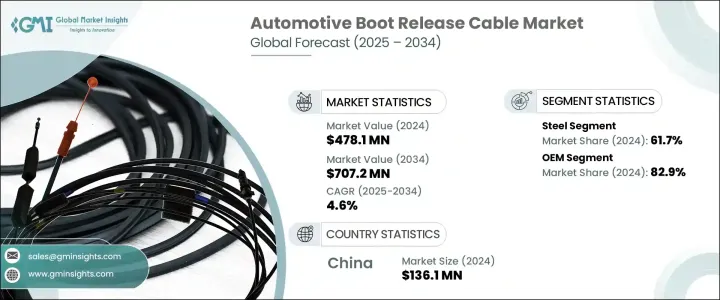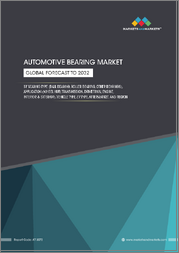
|
시장보고서
상품코드
1740847
자동차용 부츠 릴리스 케이블 시장 기회, 성장 촉진요인, 산업 동향 분석 및 예측(2025-2034년)Automotive Boot Release Cable Market Opportunity, Growth Drivers, Industry Trend Analysis, and Forecast 2025 - 2034 |
||||||
세계의 자동차용 부츠 릴리스 케이블 시장은 2024년에는 4억 7,810만 달러로 평가되었고, 2034년에는 CAGR 4.6%를 나타내 7억 720만 달러에 이를 것으로 예측되고 있습니다.
자동차의 설계가 진화하고 소비자가 자동차와의 보다 원활한 상호작용을 요구하게 됨에 따라 트렁크 액세스 시스템은 현저한 변모를 이루고 있습니다. 자동차 제조업체가 스마트 모빌리티와 전기자동차 기술을 채용하고 있는 가운데, 지능형 트렁크 시스템의 통합은 차량 설계에 있어서 중요한 특징이 되고 있습니다.

커넥티드 기술에 익숙한 자동차에 대한 선호도가 높아짐에 따라 자동차 제조업체가 트렁크 개구부와 같은 액세스 기능을 설계하는 방법을 형성하고 있습니다. 이러한 개발은 특히 전기자동차나 하이브리드 자동차에 있어서 현저하고, 효율성, 경량 설계, 스마트한 통합이 혁신의 최전선이 되고 있습니다.
| 시장 범위 | |
|---|---|
| 시작 연도 | 2024년 |
| 예측 연도 | 2025-2034년 |
| 시작 금액 | 4억 7,810만 달러 |
| 예측 금액 | 7억720만 달러 |
| CAGR | 4.6% |
진화하는 규격에 대응하기 위해 제조업체는 첨단재료의 사용과 보다 스마트한 엔지니어링 기법으로 시프트하고 있습니다. 그 중에서도 스틸이 여전히 최고의 선택이며, 2024년에는 시장의 약 61.7%의 점유율을 획득했으며, 2034년까지의 CAGR은 5%를 나타낼 것으로 예측됩니다.
유통 측면에서 2024년에는 OEM 부문이 82.9% 시장 점유율을 차지해 세계를 석권했고, 예측 기간 동안에도 리드를 유지할 것으로 예측됩니다. 보다 스마트하고 안전하며 최종 사용자에게 보다 직관적인 기능을 제공하는 차량 액세스의 미래를 따르는 기계와 전자의 하이브리드 솔루션에 대한 투자를 늘리고 있습니다.
중국은 가장 영향력 있는 지역 시장으로 대두하고 있으며, 2024년 세계 매출의 57.6%를 차지했고 2034년에는 1억 3,610만 달러에 이를 것으로 예측되고 있습니다. 중국의 선도적인 공급업체는 국제 표준과 수요를 충족하기 위해 고정밀도, 내식성 및 안전성을 강화한 케이블 시스템의 제조에 주력하고 있습니다.
THB Group, Universal Cable, Leoni AG, Nexans Auto Electric, Birla Cable, Kei Industry, TE Connectivity, Polycab, 스미토모 전기 산업, Sterlite 테크놀로지스 등의 대기업은 이 경쟁이 치열한 분야에서 우위를 차지하기 때문에 경량이고 다기능인 부트 릴리스 케이블 시스템의 설계에 주력하고 있습니다.
목차
제1장 조사 방법과 범위
제2장 주요 요약
제3장 업계 인사이트
- 생태계 분석
- 공급자의 상황
- 제조업체
- 원재료 공급자
- 자동차 OEM
- 유통 채널
- 최종 용도
- 트럼프 정권에 의한 관세에 대한 영향
- 무역에 미치는 영향
- 무역량의 혼란
- 보복 조치
- 업계에 미치는 영향
- 공급측의 영향(원재료)
- 주요 원재료의 가격 변동
- 공급망 재구성
- 생산 비용에 미치는 영향
- 수요측의 영향(고객에 대한 비용)
- 최종 시장에의 가격 전달
- 시장 점유율 동향
- 소비자의 반응 패턴
- 공급측의 영향(원재료)
- 영향을 받는 주요 기업
- 전략적인 업계 대응
- 공급망 재구성
- 가격 설정 및 제품 전략
- 정책관여
- 전망과 향후 검토 사항
- 무역에 미치는 영향
- 이익률 분석
- 기술과 혁신의 상황
- 특허 분석
- 주요 뉴스와 대처
- 규제 상황
- 가격 분석
- 추진
- 지역
- 영향요인
- 성장 촉진요인
- 차량 보안 및 액세스 시스템의 중요성 증가
- 설치가 간단하고 유지보수도 간단
- 모듈러 구성 요소의 OEM 우선
- 세계 자동차 생산의 성장
- 업계의 잠재적 위험 및 과제
- 전자화·스마트화 트렁크 시스템으로의 이행
- 낮은 교환 빈도
- 성장 촉진요인
- 성장 가능성 분석
- Porter's Five Forces 분석
- PESTEL 분석
제4장 경쟁 구도
- 서론
- 기업의 시장 점유율 분석
- 경쟁 포지셔닝 매트릭스
- 전략적 전망 매트릭스
제5장 시장 추계·예측 : 재료별(2021-2034년)
- 주요 동향
- 강철
- 알루미늄
- 플라스틱
- 기타
제6장 시장 추계·예측 : 차량별(2021-2034년)
- 주요 동향
- 승용차
- 세단
- 해치백
- SUV
- 상용차
- 경차
- 중형
- 대형
제7장 시장 추계·예측 : 추진력별(2021-2034년)
- 주요 동향
- 가솔린
- 디젤
- 전기
- PHEV
- HEV
- FCEV
제8장 시장 추계·예측 : 판매 채널별(2021-2034년)
- 주요 동향
- OEM
- 애프터마켓
제9장 시장 추계·예측 : 지역별(2021-2034년)
- 주요 동향
- 북미
- 미국
- 캐나다
- 유럽
- 영국
- 독일
- 프랑스
- 이탈리아
- 스페인
- 러시아
- 북유럽 국가
- 아시아태평양
- 중국
- 인도
- 일본
- 한국
- 호주 및 뉴질랜드
- 동남아시아
- 라틴아메리카
- 브라질
- 멕시코
- 아르헨티나
- 중동 및 아프리카
- 아랍에미리트(UAE)
- 사우디아라비아
- 남아프리카
제10장 기업 프로파일
- Auto7
- Birla Cable
- Chuhatsu
- CMA
- Dorman Products
- Dura Automotive Systems
- GEMO
- HI-LEX
- Infac Corporation
- Kei Industries
- Kongsberg Automotive
- L&P Automotive Group
- Leoni AG
- Nexans Auto Electric
- Polycab
- Sterlite Technology
- Sumitomo Electric Industries
- TE connectivity
- THB Group
- Universal Cable
The Global Automotive Boot Release Cable Market was valued at USD 478.1 million in 2024 and is estimated to grow at a CAGR of 4.6% to reach USD 707.2 million by 2034, fueled by rising global vehicle production and the growing demand for advanced vehicle access solutions. As vehicle designs evolve and consumers demand more seamless interactions with their automobiles, trunk access systems have seen a notable transformation. Boot release cables, once simple mechanical components, are now playing a vital role in enabling smarter, more secure, and more efficient trunk access across a wide range of vehicle categories. As automakers continue to embrace smart mobility and electric vehicle technologies, the integration of intelligent trunk systems is becoming a critical feature in vehicle design. Consumers expect convenience and speed, and vehicle manufacturers are responding by deploying high-performance cable systems that blend mechanical reliability with cutting-edge electronics.

The increasing preference for connected, tech-savvy vehicles is shaping how automakers design access features like trunk openings. From gesture-based triggers to mobile app-based functionalities, today's consumers want more than manual levers-they want systems that work in harmony with their digital lifestyles. This demand is driving innovation in automotive boot release cable systems that offer enhanced security, comfort, and user experience. These developments are especially visible in electric and hybrid vehicles, where efficiency, lightweight design, and smart integration are at the forefront of innovation. Automakers are now leveraging technologies that can support high durability and performance even under frequent usage and challenging environmental conditions.
| Market Scope | |
|---|---|
| Start Year | 2024 |
| Forecast Year | 2025-2034 |
| Start Value | $478.1 Million |
| Forecast Value | $707.2 Million |
| CAGR | 4.6% |
To meet the evolving standards, manufacturers are shifting toward the use of advanced materials and smarter engineering practices. Lightweight, corrosion-resistant, and high-tensile materials are becoming standard in boot release cable production. These materials not only improve product longevity but also enhance vehicle efficiency by reducing overall weight. Steel remains the top choice among materials, capturing nearly 61.7% share of the market in 2024 and projected to grow at a CAGR of 5% through 2034. Its strength, affordability, and resistance to fatigue make it ideal for parts subject to repetitive mechanical stress, especially in commercial and passenger electric vehicles that require frequent trunk access.
In terms of distribution, the OEM segment dominated the global landscape in 2024, accounting for an 82.9% market share, and is expected to maintain its lead through the forecast period. Vehicle manufacturers now treat advanced boot release systems as standard components, integrating them during production to enhance both security and convenience. OEMs are increasingly investing in hybrid mechanical-electronic solutions that align with the future of vehicle access-offering smarter, safer, and more intuitive features for the end user. This shift is particularly prominent among global automotive brands that aim to stay competitive by improving user experience from the first point of interaction.
China is emerging as the most influential regional market, representing 57.6% of global revenue in 2024, with projections hitting USD 136.1 million by 2034. The country's high volume of vehicle production, combined with its robust automotive components ecosystem, gives it a strategic edge in the global market. Leading suppliers in China are focusing on manufacturing high-precision, corrosion-resistant, and safety-enhanced cable systems to meet international standards and demand. Continuous investments in R&D and smart manufacturing practices further strengthen China's position as a global hub for advanced automotive cable technologies.
To stay ahead in this competitive space, major players like THB Group, Universal Cable, Leoni AG, Nexans Auto Electric, Birla Cable, Kei Industry, TE Connectivity, Polycab, Sumitomo Electric Industries, and Sterlite Technologies are focusing on designing lightweight, multi-functional boot release cable systems. These companies are expanding their global presence through strategic alliances and improving their manufacturing capabilities with automation and next-gen materials. Their collective focus on performance, durability, and compatibility with smart vehicle platforms ensures they remain aligned with the evolving needs of the automotive industry.
Table of Contents
Chapter 1 Methodology & Scope
- 1.1 Research design
- 1.1.1 Research approach
- 1.1.2 Data collection methods
- 1.2 Base estimates and calculations
- 1.2.1 Base year calculation
- 1.2.2 Key trends for market estimates
- 1.3 Forecast model
- 1.4 Primary research & validation
- 1.4.1 Primary sources
- 1.4.2 Data mining sources
- 1.5 Market definitions
Chapter 2 Executive Summary
- 2.1 Industry 3600 synopsis, 2021 - 2034
Chapter 3 Industry Insights
- 3.1 Industry ecosystem analysis
- 3.2 Supplier landscape
- 3.2.1 Manufacturers
- 3.2.2 Raw material suppliers
- 3.2.3 Automotive OEM
- 3.2.4 Distribution channel
- 3.2.5 End-use
- 3.3 Impact of Trump administration tariffs
- 3.3.1 Trade impact
- 3.3.1.1 Trade volume disruptions
- 3.3.1.2 Retaliatory measures
- 3.3.2 Impact on industry
- 3.3.2.1 Supply-side impact (raw materials)
- 3.3.2.1.1 Price volatility in key materials
- 3.3.2.1.2 Supply chain restructuring
- 3.3.2.1.3 Production cost implications
- 3.3.2.2 Demand-side impact (Cost to customers)
- 3.3.2.2.1 Price transmission to end markets
- 3.3.2.2.2 Market share dynamics
- 3.3.2.2.3 Consumer response patterns
- 3.3.2.1 Supply-side impact (raw materials)
- 3.3.3 Key companies impacted
- 3.3.4 Strategic industry responses
- 3.3.4.1 Supply chain reconfiguration
- 3.3.4.2 Pricing and product strategies
- 3.3.4.3 Policy engagement
- 3.3.5 Outlook & future considerations
- 3.3.1 Trade impact
- 3.4 Profit margin analysis
- 3.5 Technology & innovation landscape
- 3.6 Patent analysis
- 3.7 Key news & initiatives
- 3.8 Regulatory landscape
- 3.9 Pricing analysis
- 3.9.1 Propulsion
- 3.9.2 Region
- 3.10 Impact on forces
- 3.10.1 Growth drivers
- 3.10.1.1 Growing emphasis on vehicle security & access systems
- 3.10.1.2 Easy installation and low maintenance
- 3.10.1.3 OEM preference for modular components
- 3.10.1.4 Global vehicle production growth
- 3.10.2 Industry pitfalls & challenges
- 3.10.2.1 Shift towards electronic & smart trunk systems
- 3.10.2.2 Low replacement frequency
- 3.10.1 Growth drivers
- 3.11 Growth potential analysis
- 3.12 Porter's analysis
- 3.13 PESTEL analysis
Chapter 4 Competitive Landscape, 2024
- 4.1 Introduction
- 4.2 Company market share analysis
- 4.3 Competitive positioning matrix
- 4.4 Strategic outlook matrix
Chapter 5 Market Estimates & Forecast, By Material, 2021 - 2034 ($Mn, Units)
- 5.1 Key trends
- 5.2 Steel
- 5.3 Aluminium
- 5.4 Plastic
- 5.5 Others
Chapter 6 Market Estimates & Forecast, By Vehicle, 2021 - 2034 ($Mn, Units)
- 6.1 Key trends
- 6.2 Passenger cars
- 6.2.1 Sedans
- 6.2.2 Hatchbacks
- 6.2.3 SUVs
- 6.3 Commercial vehicles
- 6.3.1 Light duty
- 6.3.2 Medium duty
- 6.3.3 Heavy duty
Chapter 7 Market Estimates & Forecast, By Propulsion, 2021 - 2034 ($Mn, Units)
- 7.1 Key trends
- 7.2 Gasoline
- 7.3 Diesel
- 7.4 Electric
- 7.5 PHEV
- 7.6 HEV
- 7.7 FCEV
Chapter 8 Market Estimates & Forecast, By Sales Channel, 2021 - 2034 ($Mn, Units)
- 8.1 Key trends
- 8.2 OEMs
- 8.3 Aftermarket
Chapter 9 Market Estimates & Forecast, By Region, 2021 - 2034 ($Mn, Units)
- 9.1 Key trends
- 9.2 North America
- 9.2.1 U.S.
- 9.2.2 Canada
- 9.3 Europe
- 9.3.1 UK
- 9.3.2 Germany
- 9.3.3 France
- 9.3.4 Italy
- 9.3.5 Spain
- 9.3.6 Russia
- 9.3.7 Nordics
- 9.4 Asia Pacific
- 9.4.1 China
- 9.4.2 India
- 9.4.3 Japan
- 9.4.4 South Korea
- 9.4.5 ANZ
- 9.4.6 Southeast Asia
- 9.5 Latin America
- 9.5.1 Brazil
- 9.5.2 Mexico
- 9.5.3 Argentina
- 9.6 MEA
- 9.6.1 UAE
- 9.6.2 Saudi Arabia
- 9.6.3 South Africa
Chapter 10 Company Profiles
- 10.1 Auto7
- 10.2 Birla Cable
- 10.3 Chuhatsu
- 10.4 CMA
- 10.5 Dorman Products
- 10.6 Dura Automotive Systems
- 10.7 GEMO
- 10.8 HI-LEX
- 10.9 Infac Corporation
- 10.10 Kei Industries
- 10.11 Kongsberg Automotive
- 10.12 L&P Automotive Group
- 10.13 Leoni AG
- 10.14 Nexans Auto Electric
- 10.15 Polycab
- 10.16 Sterlite Technology
- 10.17 Sumitomo Electric Industries
- 10.18 TE connectivity
- 10.19 THB Group
- 10.20 Universal Cable



















